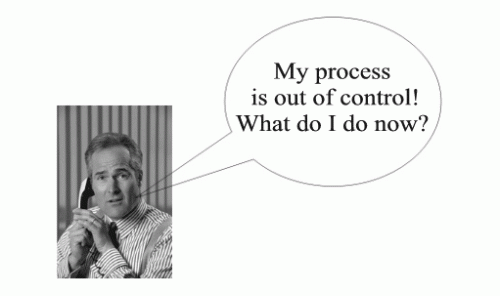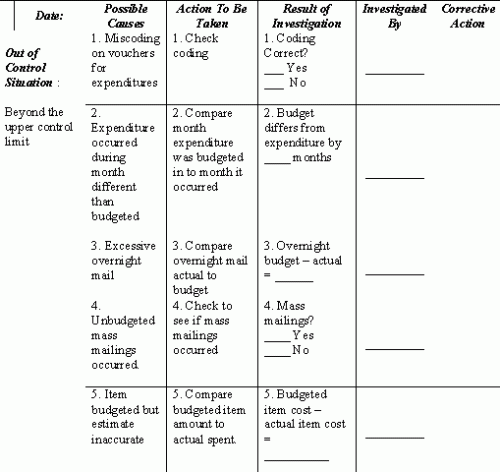In this issue:
The point you just plotted on your control chart is above the upper control limit. Your chart is telling you that there is a special cause present in your process. You are supposed to find out what caused this point to be above the upper control limit. Where do you start looking? There are thousands of things which could have caused this point to be above the upper control limit. A control strategy provides a method of helping you look for causes of out-of-control points. This e-zine introduces the concept of control strategies.
Control Strategies

Control strategies are specific action plans for bringing a process back into control. The strategies usually consist of five to ten steps that help you find reasons for special causes, and most importantly, help you do something about the causes.
Control Strategy Example
A non-manufacturing example of a control strategy is shown in the figure. This control strategy is for operating supplies variance. Operating supplies is often a category used in budgeting. Operating supplies variance is the difference between what was budgeted for operating supplies and what was actually spent.
The first column on the control strategy is a statement of the out-of-control situation. In this example, the out-of-control situation is that the operating supplies variance is below the lower control limit. Notice that the out-of-control situation only talks about the variance below the lower control limit (or seven points in a row below the average).
The control strategy for points above the upper control limits (or seven points in a row above the average) might be different. You might also have different control strategies depending on the type of chart (range or average) on which the out-of-control situation occurred.
The second column lists the five to ten most probable causes for the out-of-control situation described. The third column indicates what action needs to be taken to investigate each cause. The results or information from the action taken is recorded in the fourth column. The next column is for the initials or the name of the person who took action. The last column is the action taken to correct the problem.

Control Strategy Basics
Control strategies should be developed and used by the local work force. Those people closest to the process will know best what the most likely causes of an out-of-control situation are, and what to do about them. In addition, out-of-control situations should be addressed immediately. For this reason, the responsibility for using control strategies also lies with the local work force.
Control strategies should be updated regularly. If one of the causes on the control strategy has never surfaced as a reason for an out-of-control point, then that cause should be deleted from the strategy and replaced by another possible cause (and the action to be taken for pursuing the new cause).
There are various benefits to control strategies. Control strategies provide a method of systematically looking for special causes. This helps front-line personnel to do their jobs better. Also, control strategies help us increase the understanding of our processes. For example, if you use and update control strategies over time, you will establish a database that will evaluate the causes of out-of-control points long term. This increased knowledge about our processes will be useful for training new hires. They will have a standardized approach for controlling their processes instead of working by trial and error. Control strategies also provide a permanent record of what happened after each out-of-control situation.
Control strategies are specific plans for what to do when your process shows the presence of special causes. This plan describes the out-of-control situation, possible causes, how to check each cause and the result of your check. All control charts in use should have a control strategy. It is the responsibility of those people closest to the process to develop and use the control strategies.